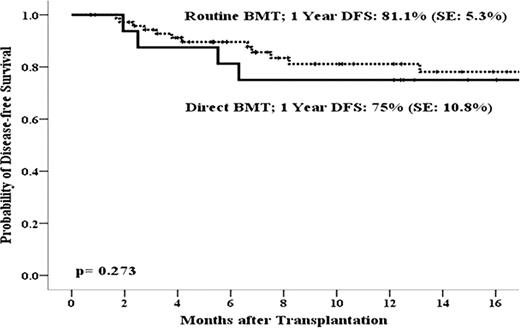Abstract
Abstract 4487
Eighty percent of acute lymphoblastic leukemia (ALL) patients achieve a complete remission (CR) but only 30–40% are long-term survivors. Hematopoietic stem cell transplantation (HSCT) is only curable treatment in ALL patients. However, the efficacy of induction, consolidation chemotherapy and early hematopoietic stem cell transplantation remain unclear.
Therefore, at our center, patients with newly diagnosed ALL, are randomly divided into 2 arms from 2008 to 2011. Patients in the study arm received reduced induction chemotherapy (Vincristine 1 mg/m2 every week for 4 weeks plus Dexamethasone 24mg/d for 28 days) and undergone early HSCT after disease stabilized within 15–30 days without intention of achieving complete remission (CR). The control arm received conventional chemotherapy (routine induction and then consolidation) followed by HSCT. Both arms received Busulfan (4mg/kg for 4 days) plus Cyclophosphamide (60mg/kg for 2 days) as a conditioning regimen. The GVHD prophylaxis consisted of Methotrexate plus Cyclosporine. Here, we compare the efficacy of these two kinds of treatment.
Overall Survival of ALL Patients in Study arm vs. Control arm
Overall Survival of ALL Patients in Study arm vs. Control arm
Disease-free Survival of ALL Patients in Study arm vs. Control arm
Disease-free Survival of ALL Patients in Study arm vs. Control arm
Reduced induction followed by early transplantation without consolidation reveals no significant statistical different outcome compared with routine treatment. This result might be due to small size of patients and short time of follow-up. A study with more cases and long time follow-up is recommended.
No relevant conflicts of interest to declare.
Author notes
Asterisk with author names denotes non-ASH members.



This feature is available to Subscribers Only
Sign In or Create an Account Close Modal